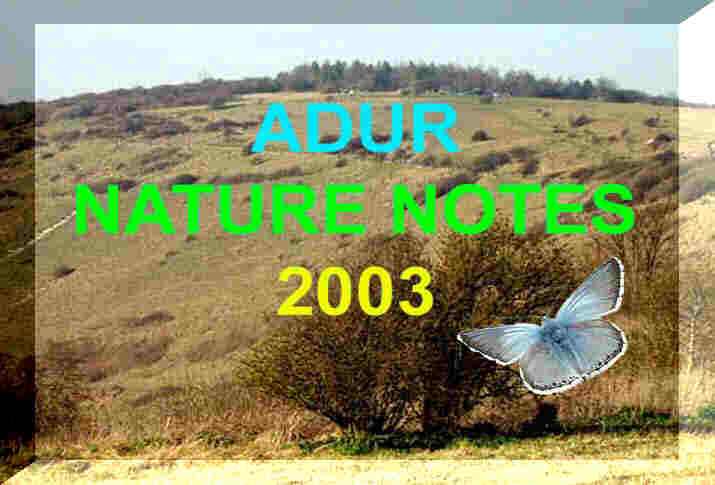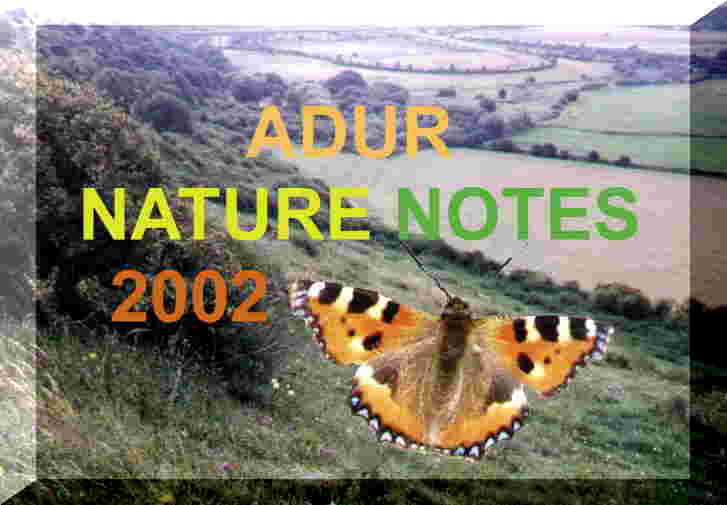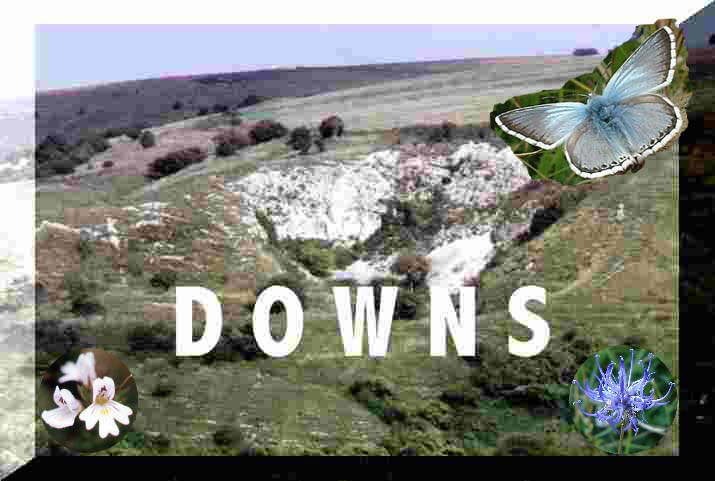|
May
2004
*
If the grid references are not given they could be found on the
Adur
Wildlife database on the Adur
eForum
Reports
by Andy Horton from personal observation unless
otherwise indicated

Adonis
Blue Butterfly
WILDLIFE
REPORTS
31
May 2004
Large
Red Damselflies,
Pyrrhosoma
nymphula, are seen in at least two
Shoreham
garden ponds in Mill Lane and in a back garden
in The Drive. In Mill Lane, the Blue-tailed
Damselfly,
Ischnura
elegans, was
also in flight over the pond and probably Azure
Damselflies, Coenagrion
puella, as well.
In
a pond in a south Lancing
garden (TQ 186 044), the
dragonfly larvae (image)
appears to be a Sympetrum species possibly the Common
Darter.
On
Southwick
beach a shrimp fisherman (push-netting) reported
a juvenile Thornback Ray, Raja
clavata, in his four foot net.
Adur
Seashore
BMLSS
Sharks and Rays
26
May 2004
I
was not sure if it it was two or three species of damselfly I was viewing
over the thistles and tall nettles in the
narrow field next to the stream by the Steyning Road (TQ
209 068). The males and females of over 30
Azure
Damselflies,
Coenagrion
puella, look appreciably different,
and the head of the females are often black and white.

The
other species, the Large Red Damselfly,
Pyrrhosoma
nymphula, was the first time I have
seen this common species, although other observers have seen it and it
is usually the first species reported each year.
Adur
Damselflies and Dragonflies
Adur
Damselflies & Dragonflies Local
Flight Times
British
Dragonfly Society
UK
Dragonflies (Yahoo Group)
British
Insects (Yahoo Group)
25
May 2004
Common
Blue Butterflies appear on the Lancing
Ring meadows.
Image
of Male
Image
of Female
On
the eastern road verge to the south-west of New House Farm (Upper Beeding)
on the A2037
where the Beeding and Bramber road leaves the A283
Shoreham (to Steyning) Road (TQ 198 099) a
brown
butterfly flew around energetically and refused
to settle. It was almost certainly a Wall
Brown Butterfly,
the first of the year, but I was unable to confirm this.
The
first Common
Blue Butterfly of
2004 was spotted in the buttercup
strewn field north-west of Beeding Hill car
park. Skylarks
were in song and flight over the downs and a dozen or so Rooks
probed the soil on Beeding Hill with their silver beaks.

Down
on the Adur Levels, a dozen or more Common
Blue Butterflies flew amongst the tall vegetation
on the verge of the cyclepath near the abandoned Beeding (Shoreham) Cement
Works. It was difficult to be sure of their numbers as many would be successfully
hiding.
Adur
Butterfly List 2004
Adur
Butterflies Flight Times
Adur
First Butterfly Dates 2004
 23
May 2004 23
May 2004
The blooming
of the Horseshoe Vetch
was even more impressive on the lower slopes
of Mill Hill than last year after the recent
rain, but there were the first signs that the flowers are beginning to
diminish. Of the 19 Adonis Blue Butterflies,
just one was a brown female
with a lot of blue on its upper wings and body. Small
Heath Butterflies, Dingy
and Grizzled Skippers
were there as well as would be expected at this time of the year.
Full
Report
Adur
Butterflies
On the
Slonk
Hill North road embankment 12 Small
Blue Butterflies were roosting in the
long vegetation in the late afternoon.
 On
the edge of the horse's field on the south-west
approaches of Mill Hill, (south of the
A27 main road), on the pile of dung next to the footpath two clumps of
about 20 mushrooms were growing. It is a species of Conocybe.
There
are seventy
nine species of
Conocybe found
in Britain.
Full
Report (with photographs)
Fungi
of Shoreham
Adur
Fungi: Fruiting Bodies (Monthly Guide)
22 May
2004 On
the edge of the horse's field on the south-west
approaches of Mill Hill, (south of the
A27 main road), on the pile of dung next to the footpath two clumps of
about 20 mushrooms were growing. It is a species of Conocybe.
There
are seventy
nine species of
Conocybe found
in Britain.
Full
Report (with photographs)
Fungi
of Shoreham
Adur
Fungi: Fruiting Bodies (Monthly Guide)
22 May
2004
Perched
on the top of a Hawthorn, the colourful red breast of a Linnet
was
a pleasing change from the omnipresent
House
Sparrows on the path
south-east of Old Shoreham Toll
Bridge.
Full
Report
May
2004
A
bloom of plankton, probably Phaeocystis
pouchetti, has turned the River
Adur almost orange and considerably reduced visibility in the enriched
sea. The colonies of this flagellate organism
Phaeocystis can
be seen in the water at over 1 mm long and plankton will be continuous
for miles of milky sea water. The sea is then by various local terms like
Slobweed or Baccy Water because of its appearance. When the plankton dies
it can create hypoxic conditions and generally the inshore fauna is diminished
in quantity and variety.
Marine
Life (Sussex) 2004
Intertidal
Life (Adur) 2004
19
May 2004
In
the field between the Waterworks (at Old Shoreham) and the east side of
the Steyning Road, it was really fascinating just how attached the
smaller yellow butterfly was, as a pair of Green-veined
White Butterflies were mating despite
being bothered by other butterflies of the same species. There were about
half a dozen in flight, the other four were soloists.

|

|
|
|
Green-veined
White Butterflies mating
|
Yellow
Flag Iris by the stream
|
|
There
were about the same number of Azure Damselflies, Coenagrion
puella, with at least four of them male and these were over the prickly
thistles
and nettles rather than the stream.
British
Dragonfly Society
Adur
Damselflies and Dragonflies
On
the cyclepath to
the north of the flyover, I spotted the colourful orange wing tips
of the male Orange Tip Butterfly
twice in quick succession. The attendant whites were thought to be their
suitors. This is the first time this species of butterfly has been recorded
in this area.
Adur
Butterflies
Warblers
were warbling in the shrubbery. According to experienced birdwatcher Alan,
there were both Reed Warblers
and Sedge Warblers.
Adur
Levels
Not
a cloud in the sky and temperature reached 22.6 ºC early on a sunny
afternoon.
Shoreham
Weather Station
18
May 2004
 One
specimen of the Grey Sea Slug,
Aeolidia
papillosa, is seen under Worthing
Pier laying its white spawn coil under a small flint rock. This sea
slug dies after spawning. Its diet consists entirely of sea
anemones. The numbers vary from year to year, sometimes absent altogether
and other years they can be found in dozens, often in their final death
throes. The 1.1 metre low tide just exposed the
the end of the pier, but apart from a few juvenile Blennies,
Lipophrys
pholis, and
Snakelocks
Anemones,
Anemonia
viridis, the shore fauna was not
very interesting. One
specimen of the Grey Sea Slug,
Aeolidia
papillosa, is seen under Worthing
Pier laying its white spawn coil under a small flint rock. This sea
slug dies after spawning. Its diet consists entirely of sea
anemones. The numbers vary from year to year, sometimes absent altogether
and other years they can be found in dozens, often in their final death
throes. The 1.1 metre low tide just exposed the
the end of the pier, but apart from a few juvenile Blennies,
Lipophrys
pholis, and
Snakelocks
Anemones,
Anemonia
viridis, the shore fauna was not
very interesting.
17
May 2004
The
Small
Blue Butterfly is confirmed from Slonk
Hill where the first Adonis Blue Butterfly
of the year was also seen with a Grizzled
Skipper and a Small
White Butterfly or two. Two more Adonis
Blues were seen on Mill
Hill.
Full
Report from Slonk Hill
There
appeared to be at least one Hairy Violet,
Viola
hirta, with blunt sepals and hairy leaves
on the lower slopes of Mill Hill.
Violets
of Mill Hill
16
May 2004
 Close
examination of the Horseshoe Vetch on
Slonk
Hill (A27 north road embankment) revealed this plant to be growing
upright in clumps, In this respect they differ from the prostrate form
on the lower slopes of Mill
Hill. There were a handful of small dark blue butterflies fluttering
over the Horseshoe Vetch
and Common Vetch
on the steep chalk south-facing bank in the humid sunshine as the traffic
roared past. The air temperature reached the
the highest of the year so far at 24.1 ºC. Small
Blue Butterflies are a new butterfly (the
thirtieth) to be recorded on the Nature Notes pages and were quick to hide
in the dense and varied vegetation on the chalk bank. I counted half a
dozen, but I would estimate that there were at least a dozen in flight
in the hot sunshine around midday, but they were not be be seen when I
returned in the evening. The butterflies on the southern bank were Holly
Blues which are similar in appearance. Close
examination of the Horseshoe Vetch on
Slonk
Hill (A27 north road embankment) revealed this plant to be growing
upright in clumps, In this respect they differ from the prostrate form
on the lower slopes of Mill
Hill. There were a handful of small dark blue butterflies fluttering
over the Horseshoe Vetch
and Common Vetch
on the steep chalk south-facing bank in the humid sunshine as the traffic
roared past. The air temperature reached the
the highest of the year so far at 24.1 ºC. Small
Blue Butterflies are a new butterfly (the
thirtieth) to be recorded on the Nature Notes pages and were quick to hide
in the dense and varied vegetation on the chalk bank. I counted half a
dozen, but I would estimate that there were at least a dozen in flight
in the hot sunshine around midday, but they were not be be seen when I
returned in the evening. The butterflies on the southern bank were Holly
Blues which are similar in appearance.
The
first Green-veined White Butterfly on
the lower (tidal reaches) Adur Valley appeared in a back
garden in Shoreham near Buckingham Park (TQ
219 063) which is out of place as this is
a countryside and waste land species.
Adur
Butterflies
15
May 2004
A
year ago a large expanse of the Widewater flood plain
was bare gravel because it all had been churned over to construct the new
pipeline.

Colonisation
was expected to be swift and one year later the shingle is covered by the
blue-violet of Ivy leaved Toadflax,
with splatterings of other ground-hugging plants like Scarlet
Pimpernel, small patches of Stonewort,
clumps of Sea Campion,
one or two Bird's Foot Trefoil,
and a few small Sea Kale plants. Sea
Thrift produced the usual attractive sweeps
over the gravel, but none of this had actually sprouted forth from the
disturbed ground. A Ringed Plover
was well camouflaged against the shingle and plants.
There
were thousands of small prawns, probably Palaemon
elegans but there were still no 3-spined
Sticklebacks, Gasterosteus
aculeatus, to be seen. There was one new
very small fish species though: the Common
Goby,
Pomatoschistus
microps, which was to be expected* with the new pipeline and might
have even have occurred before. (* It is found in Hove Lagoon.) A handful
were seen, but there are probably hundreds.
 13
May 2004 13
May 2004
The
Horseshoe
Vetch is now flowering over almost its
complete range on the lower slopes of Mill
Hill, including the southern end of the steeper slopes that was not
showing at all a week ago and could not be seen from a distance three days
ago. The only butterflies on the lower slopes
of Mill Hill were Dingy Skippers (12),
Small
Heath (1),
Small
White (1) and
Peacock
(1).There
was a Pyrausta
nigrata moth and one Wave
Moth, Cabera sp.
12
May 2004
After
the Widewater Lagoon Management Committee meeting, I compiled an article
on part of the ecology of Widewater Lagoon
relating to salinity, concluding that
the seawater pipeline intake would confer advantages to the biodiversity
of the lagoon during the summer months but would show no benefits during
the winter and around the time of the equinoctial spring tides.
Article:
Is Widewater Lagoon turning into a Seawater Inlet?
Report
and Conclusion
Scores
of House Martins
filled the sky over the Adur Levels.
11
May 2004
A
male Whinchat was
singing in the fog from the Carrot's Cafe car park, by Shoreham Harbour
Power Station (at Southwick) in the early morning rush hour.
10
May 2004
I've
recently seen two examples of a creature washed up on Shoreham Beach that
I never seen before, and can't find in my book of seaside flora and fauna.
I presume it's a type of jellyfish. Can you identify it please?
It's
like the head of an old-fashioned string floor mop. The diameter of the
'mop' head is about 25 cm. The densely packed 'strings' are the thickness
of an earthworm and about 10 cm long each from the centre of the 'mop'.
The colour is a very pretty pale coral pink and white. Have you any ideas?
Is it rare?
The
most recent one I saw was on the Ferry Road beach (just west of the beach
directly opposite Ferry Road) on the sand at low tide.
Intertidal
(Adur beaches)

East
of Mill Hill, the first Rook
appeared, followed by a pair east of Erringham Hill, and at Anchor
Bottom and Beeding Hill to the north over 300
Rooks probed in the grasslands. Alas, the
cow pasture at Anchor Bottom was dried cow pats (without the cows) and
attendant Panaeolus sphinctrinus mushrooms.
Historically, the exposed west facing escarpment of Anchor Bottom had a
reputation for butterflies, but there was
a complete absence of both Horseshoe Vetch
and Bird's Foot Trefoil (the
important food plants for blue butterflies).
On
both the lower and middle
slopes of Mill Hill, the Horseshoe
Vetch was flowering clearly with a yellow
expanse, but it was still a week off its best.
Fungi
of the Downs in May 2004
6 May
2004
Sparrows
scattered in multiple directions and a low flying brown bird of prey flew
by at tremendous speed near St. Nicolas Church, Old Shoreham. This was
identified as a male Kestrel,
and was another report of this bird of prey chasing Sparrows,
although I have not had a report of a Kestrel
catching one yet..
Report
by Mike Burtt
Town
& Gardens 2004
2 May
2004
A
Large
White Butterfly, the first of the year
is seen in the back garden of 40 The Drive (near
Buckingham Park), (TQ 219 063). My
first Small Heath Butterfly,
the first of just three (and the first recorded in Britain this year by
the Butterfly Conservation
Society), were amongst a handful of Dingy
Skippers and a Brimstone
Butterfly on the lower
slopes of Mill Hill.
Adur
Butterflies Flight Times
Adur
First Butterfly Dates 2004
Adur
Butterflies
1 May
2004
Three
sleek birds of prey flew in under the mist on Southwick
beach. These were a complete surprise and identified as immigrant Hobbies.
Report
by June Brown
June
2004 Reports
April
2004 Reports

Mill
Hill 2004 (with new map)
History
of Mill Hill
Mill
Hill News Reports 2004
Chalk
Downs 2004
Flora
of Shoreham-by-Sea
Adur
Valley Biodiversity Network (forum)
MultiMap
Aerial Photograph of the Adur Levels and Downs
Urban
Wildlife Webring
 
ADUR
NATURE NOTES 2000

|
 On
the edge of the horse's field on the south-west
approaches of Mill Hill, (south of the
A27 main road), on the pile of dung next to the footpath two clumps of
about 20 mushrooms were growing. It is a species of Conocybe.
There
are seventy
nine species of
Conocybe found
in Britain.
On
the edge of the horse's field on the south-west
approaches of Mill Hill, (south of the
A27 main road), on the pile of dung next to the footpath two clumps of
about 20 mushrooms were growing. It is a species of Conocybe.
There
are seventy
nine species of
Conocybe found
in Britain.